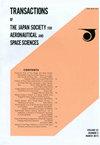微卫星编队飞行合成孔径望远镜相对位置和姿态的µm级控制
IF 0.7
4区 工程技术
Q4 ENGINEERING, AEROSPACE
Transactions of the Japan Society for Aeronautical and Space Sciences
Pub Date : 2021-01-01
DOI:10.2322/TJSASS.64.101
引用次数: 1
摘要
地球静止轨道遥感可以实现高时间分辨率;然而,空间分辨率通常比近地轨道观测差。为了实现高频高分辨率GEO遥感,提出了一种多微卫星组成的“编队飞行合成孔径望远镜”(FFSAT)。FFSAT采用合成孔径技术,极大地提高了空间分辨率。因此,必须控制各卫星光学单元之间的相对位置和姿态,其精度优于观测波长的1/10。然而,即使是毫米级的精度控制也没有在轨道上得到证明。作为FFSAT的第一个实际应用,正在考虑利用红外线进行森林火灾监测任务,由于其波长比可见光长,因此控制精度要求较低。提出了一种在无传感器情况下控制编队飞行精度约为1 ~ 1000倍波长(1 μm-1mm)的点扩展函数优化方法,可实现μm精度的绝对距离测量。通过卫星系统与光学系统的耦合仿真,验证了该方法的有效性。仿真结果表明,该方法可以在波长阶内控制信号的形成。本文章由计算机程序翻译,如有差异,请以英文原文为准。
µm-class Control of Relative Position and Attitude for a Formation Flying Synthetic Aperture Telescope with Micro-satellites
Earth remote sensing from geostationary orbit (GEO) can realize high temporal resolution; however, the spatial resolution is commonly worse than observation from low Earth orbit. In order to achieve high-frequency and high-resolution GEO remote sensing, a “Formation Flying Synthetic Aperture Telescope (FFSAT)”with multiple micro-satellites has been proposed. The FFSAT greatly improves the spatial resolution using a synthetic aperture technique. Therefore the relative positions and attitudes between the optical units of each satellite must be controlled with an accuracy better than 1/10 of the observation wavelength. However, even mm-class accuracy control has not been demonstrated on orbit. As a first practical application of the FFSAT, a forest fire monitoring mission using infrared rays is being considered, in which control accuracy requirement is relaxed as its wavelength is longer than visible light. We proposed a point spread function optimization method for controlling formation flying with an accuracy of approximately 1–1,000 times the wavelength (1 μm–1mm) in the absence of sensors, which can measure absolute distance with μm-accuracy. The effectiveness of the method was demonstrated through simulations in which the satellites’ system and the optical system are coupled. The simulation results show that the method can control the formation within the wavelength order.
求助全文
通过发布文献求助,成功后即可免费获取论文全文。
去求助
来源期刊
CiteScore
1.80
自引率
0.00%
发文量
18
审稿时长
>12 weeks
期刊介绍:
Information not localized

 求助内容:
求助内容: 应助结果提醒方式:
应助结果提醒方式:


